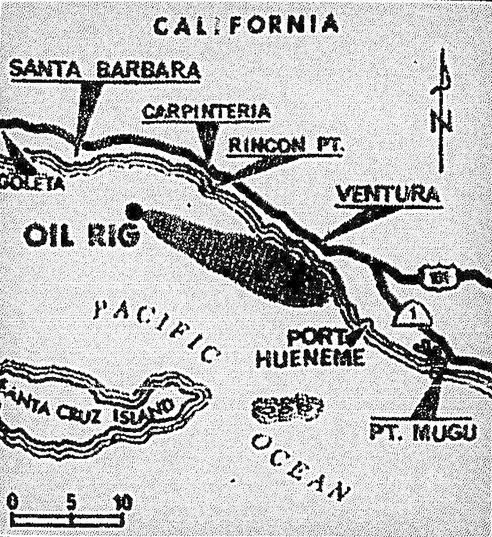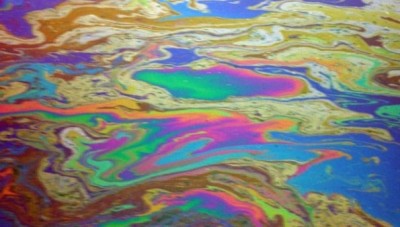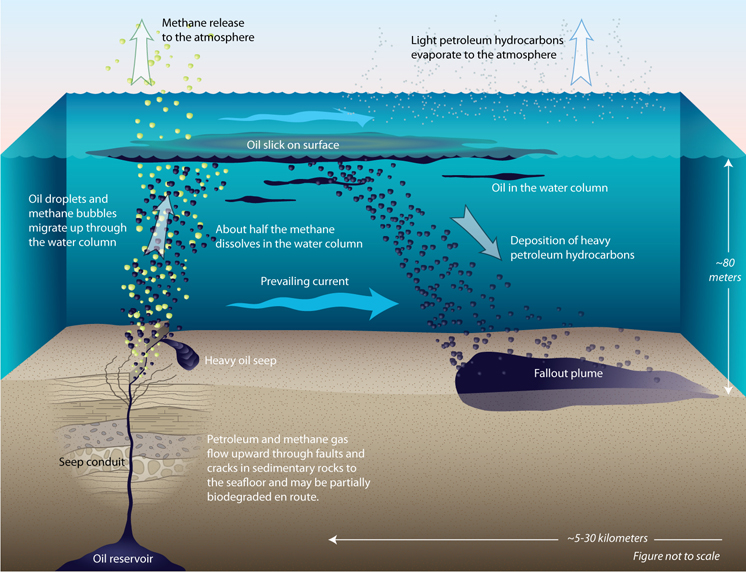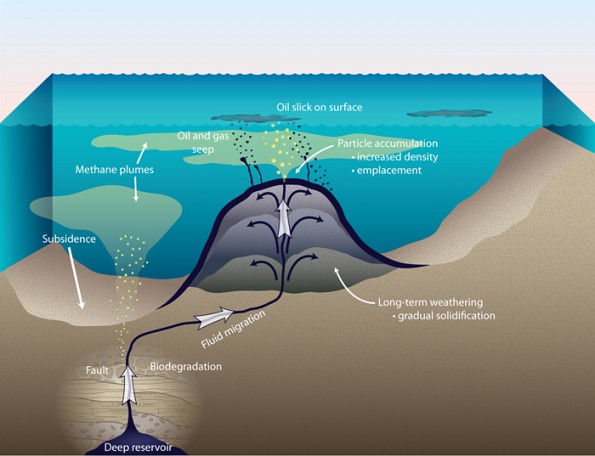Exploring the 1969 offshore disaster and the geology of ancient natural petroleum seeps.
A 1969 oil spill from a California offshore platform transformed the public’s view of the U.S. petroleum industry and helped launch the modern environmental movement — and the Environmental Protection Agency. Ancient natural seeps continue to produce thousands of tons of oil every day.
On January 28, 1969, after drilling 3,500 feet below the ocean floor, a Union Oil Company drilling platform six miles off Santa Barbara, suffered a blowout. Between 80,000 and 100,000 barrels of oil flowed into the Pacific Ocean and onto beaches, including at Summerland, where the U.S. offshore industry began in 1896 with drilling on oil well piers.

“The techniques, equipment and resources necessary to combat an oil spill of this magnitude did not exist at the time,” notes one expert about the 1969 well blowout.
Problems at the Union Oil platform began when roughnecks began to retrieve the pipe in order to replace a drill bit and pressure became dangerously low, according to a report by the University of California, Santa Barbara (UCSB).
“A natural gas blowout occurred. An initial attempt to cap the hole was successful but led to a tremendous buildup of pressure. The expanding mass created five breaks in an east-west fault on the ocean floor, releasing oil and gas from deep beneath the earth,” UCSB noted.
It would take workers days to control the well — by pumping drilling mud down the borehole at a rate of 1,500 barrels an hour. “The techniques, equipment and resources necessary to combat an oil spill of this magnitude did not exist at the time,” explained UCSB geologist Keith C. Clarke.
“On the eleventh day, chemical mud was successfully used to seal the cracks in the seafloor, but only after approximately three million gallons of oil escaped,” Clarke added.
In the spring following the oil spill, Earth Day was born nationwide. “Many consider the publicity surrounding the oil spill a major impetus to the environmental movement,” Clarke said.

California’s major petroleum fields are included in this 2010 U.S. Geological Survey map.
As as public opinion turned against the petroleum industry and offshore exploration, President Richard Nixon on December 2, 1970, signed an executive order establishing the U.S. Environmental Protection Agency (EPA). His action combined several federal agencies regulating the industry
“Images of spilled oil bubbling to the ocean’s surface and covering birds and other wildlife have firmly cemented in much of the public mind that offshore drilling is dangerous,” noted Drew Thornley in Energy & the Environment: Myths & Facts.

Natural offshore seeps leak tons of oil every day — and have for thousands of years. Photo by Dave Valentine, University of California, Santa Barbara.
“Thus the means by which the U.S. obtains about 25 percent of the nation’s natural gas production and about 24 percent of its oil production have become, understandably, linked to environmental degradation,” Thornley added.
In October 2022, the Energy Information Administration (EIA) reported federal offshore oil and natural gas production in the Gulf of Mexico accounted for about 15 percent of total U.S. crude oil production and about 2 percent of total U.S. dry natural gas production.
According to the National Research Council, natural geologic processes are responsible for more than 60 percent of all the oil that enters North American ocean waters — accounting for more than 45 percent of the petroleum entering ocean waters worldwide.
Science of Seeps
A detailed study by Woods Hole and UCSB in 1990 was the first to quantify the amount of oil residue in seafloor sediments from natural petroleum seeps off Santa Barbara.
The study estimated the amount of oil in the sediments down current from the seeps to be the equivalent of approximately 80 Exxon Valdez oil spills. Most of the oil is degraded by microbes over time.

A 2009 study by the Woods Hole Oceanographic Institution and the University of California, Santa Barbara, was “the first to quantify the amount of oil residue in seafloor sediments that result from natural petroleum seeps off Santa Barbara, California.” This graphic depicts what happens to the oil from a natural seep.
Researchers found that natural offshore seeps near Goleta, California, alone have leaked up to 25 tons of oil each day — for the last several hundred thousand years.
In Santa Barbara County, beached tar balls indicated the Summerland field extended into the Pacific — leading turn-of-the-century oil companies to build piers.

“The area around Santa Barbara is very geologically active, because of the movement of the San Andreas and other faults. Extensive faulting or rupturing in the Earth allows oil and gas from subterranean reservoirs to seep up to the seafloor and ultimately into the ocean and to the atmosphere. But some oil solidifies to create asphalt volcanoes.” — Woods Hole Oceanographic Institution.
Public debate continues about protecting the environment of coastal California. “Ironically, research shows that drilling can actually reduce natural seepage, as it relieves the pressure that drives oil and gas up from ocean floors and into ocean waters,” noted Thornley in his Energy & the Environment: Myths & Facts.

Oil seeps in the vicinity of the Summerland field have existed since prehistoric times, according to geologists. The U.S. offshore exploration industry began there in 1896 with cable-tool drilling rigs on piers. A 2009 view of the beach, a California tourist destination, courtesy Wikipedia.
In 1999, two peer-reviewed studies found that natural seepage in the northern Santa Barbara Channel “was significantly reduced by oil production,” he concluded. Researchers found that seepage declined 50 percent over two decades because, “as oil was pumped from the reservoir, the pressure that drives natural seepage dropped.”
The Santa Barbara Maritime Museum educates visitors about California’s offshore industries, including the diving technologies used in the Santa Barbara Channel. Exhibits explain the continuing process of oil and natural gas emerging from natural seeps in the channel — now visited by tourists in boats.
To protect southern California’s beaches, one community organization, Stop Oil Seeps California, has advocated lifting the state and federal moratoriums on offshore oil exploration and production, maintaining that “only through education can Californians and Americans learn the truth about the massive amounts of natural oil and gas seepage pollution coming from offshore Santa Barbara, California’s coastal areas.”
Learn more about offshore exploration and production technologies at the Ocean Star Offshore Drilling Rig & Museum.
_______________________
Recommended Reading: Slick Policy: Environmental and Science Policy in the Aftermath of the Santa Barbara Oil Spill (2018); Pico Canyon Chronicles: The Story of California’s Pioneer Oil Field
(1985); Drilling Technology in Nontechnical Language
(2012) . Your Amazon purchase benefits the American Oil & Gas Historical Society. As an Amazon Associate, AOGHS earns a commission from qualifying purchases.
_______________________
The American Oil & Gas Historical Society (AOGHS) preserves U.S. petroleum history. Become an AOGHS annual supporting member and help maintain this energy education website and expand historical research. For more information, contact bawells@aoghs.org. Copyright © 2024 Bruce A. Wells. All rights reserved.
Citation Information: Article Title: “Oil Seeps and Santa Barbara Spill.” Authors: B.A. Wells and K.L. Wells. Website Name: American Oil & Gas Historical Society. URL: https://aoghs.org/offshore-history/california-oil-seeps. Last Updated: January 21, 2024. Original Published Date: April 29, 2016.


